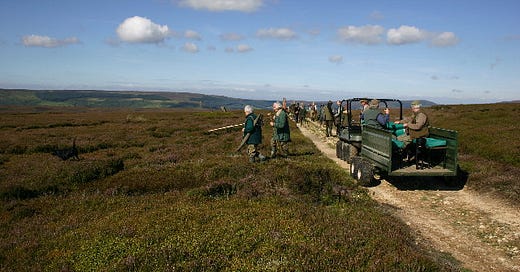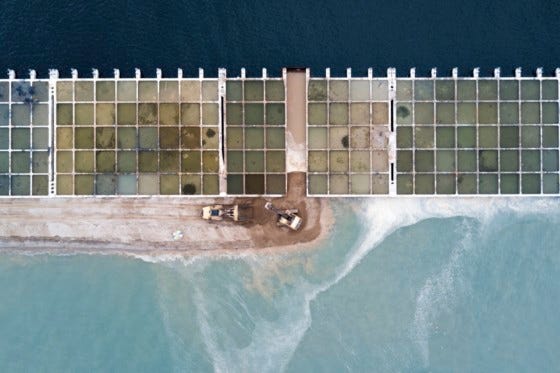Welcome to Just Two Things, which I try to publish daily, five days a week. Some links may also appear on my blog from time to time. Links to the main articles are in cross-heads as well as the story.
Today is the so-called “Glorious Twelfth”—when the shooting season for red grouse opens in the UK, for four months. Grouse shooting is unique to the UK, and the industrial version—‘driven’ grouse shooting, in which beaters drive grouse out of the heather moors, in Scotland and the north of England so that they can be shot at—was invented in the 19th century as a pastime for the wealthy.
(Grouse shooting at Slape Wath Moor, via Wikipedia)
Of course, almost everything you’d expect to be true about ‘driven’ grouse shooting turns out to be true. It takes up a huge amount of land (more on this below). It’s a sport for the wealthy, but of course the beaters aren’t well-off. It involves considerable damage to the heather moors, which are systematically burnt down to the peat, which in turns is a climate change risk. There is a well-researched view that grouse estate gamekeepers kill (protected) big birds of prey. It’s hard to work out if it damages employment prospects in the rural countryside, since most of the studies that have been commissioned have set out to demonstrate the economic value of killing grouse rather than testing the alternatives.
'Walked up shooting’ is generally held to have none of these disadvantages, although the industry association sniffily notes that it’s only driven shooting that makes the UK distinctively different. They don’t spell out why, but it may be because of the opportunities to shoot a lot of birds rather than only a few of them.
A little history first.
Sportsmen experimented with grouse driving during the early years of the 19th century as a means of securing larger bags... By the 1890s, driven grouse shooting had become the principal mode of killing grouse on all of the larger moors in England, Wales and Scotland and on many of the smaller moors, too.
The record grouse shoot dates from 1915, and the scale of it is eye-watering:
Red grouse shooting on a large scale really began from the 1870s onwards, with ever-increasing annual bags culminating in a record for the period when eight Guns brought down 9,929 birds on the Earl of Sefton’s Abbeystead estate in Lancashire on 12 August 1915. The development of grouse shooting as a sport was helped immensely by the extension of the railway system to the north of England and Scotland, thus making it possible to travel from London and the south of England to the north in hours instead of days.
To my eyes, the environmental argument against grouse moors, from the Scottish campaign Revive, seems strong:
Huge swathes of Scotland are dominated by grouse moor management and they are known to cause environmental damage to much of our land. Muirburn is a process where heather is burnt in patches or strips on a mass-scale, to make the environment more suitable for maintaining grouse at unnaturally high numbers. The more intensively managed the land is, the more grouse there are for sport shooting and the more environmental damage that ensues....
Peatland in Scotland stores almost 25 times as much carbon as all trees and plants in the UK... Yet around 40% of the total burned area for grouse in Scotland overlies deep peat... When peat is degraded its ability to store carbon is diminished and it can instead release it into the atmosphere. Decision-makers will soon have to decide if a few extra grouse for sport shooting are worth the environmental cost.
Or there’s the land use argument, from Rewilding Britain:
A total of 852,000 acres – an area more than twice the size of Greater London – of Britain’s national parks are devoted to intensively-managed grouse shoots, known as driven grouse shooting, according to figures released today by the environmental charity.
Of the six national parks that contain grouse moors – which are found only in Scotland and northern England – almost a third of their combined land area (27%) is devoted to driven grouse shoots, which keep the land in a degraded state, contribute to climate breakdown, and prevent significant recovery of wildlife.
And in the Cairngorms National Park almost 44% of the land area is given over to grouse moors. The adverse effects of managing moors to ensure that they work for driven grouse shooting means that the Scottish government is planning to introduce a new licensing regime and also to regulate some of the clearly adverse environmental practices involved in intensively rearing red grouse. This has led to dark predictions about Scottish grouse moors being abandoned. This would have an adverse effect, if the moors were simply left to their own devices.
All the same, channelling my inner rationalist, if you want an alternative perspective, the Game and Wildlife Conservation Trust is happy to provide one. Their note is light on climate change risks, however. In saying that, the whole industry feels like it’s on the wrong side of the most important countryside trends—or ethical trends, come to that. And even the economics of the moors are changing: there are other revenue streams available, which means that you don’t to have necessarily to find rich customers who want to shoot birds in large numbers.
#2: Photographing the Anthropocene
Magnum (the photographers’ collective) has an article on the issues involved in photographing the Anthropocene.
Of course, the pictures are fantastic.
(Sim Chi Yin, Singapore. Tuas. 2017. From "Shifting Sands", 2017 - on-going. Land reclamation works are on-going at this area of Tuas, Singapore's westernmost area where a new massive container port is being constructed.)
One that caught my eye was by Sim Chi Yin, who had changed her practice from photographing at ground level to an aerial view as a result of thinking about climate change:
”I think this is a deeper question about whether photography and photographers are expected to be advocates and activists as well,” she continues. “There are things that may translate photographically into climate change and some things that don’t”. Sim has been working on her project Shifting Sands, documenting the social and environmental cost of the land reclamation industry in East and Southeast Asia. Previously taking an ‘infrastructural gaze’, shot at ground level, capturing the people and places affected, she has since adopted a birds-eye view, producing strikingly beautiful other-wordly landscape photography.
It’s not uncommon to hear criticism of photography, particularly in the realm of editorial, for making terrible things look too beautiful. This is an all too familiar conundrum for (Toby) Smith in his work at Climate Visuals: “I spend a lot of my time arguing with the media about social science but the other side is that I spend a lot of time arguing with social scientists about the subjective qualities of photography,” he says.
j2t#147
If you are enjoying Just Two Things, please do send it on to a friend or colleague.




